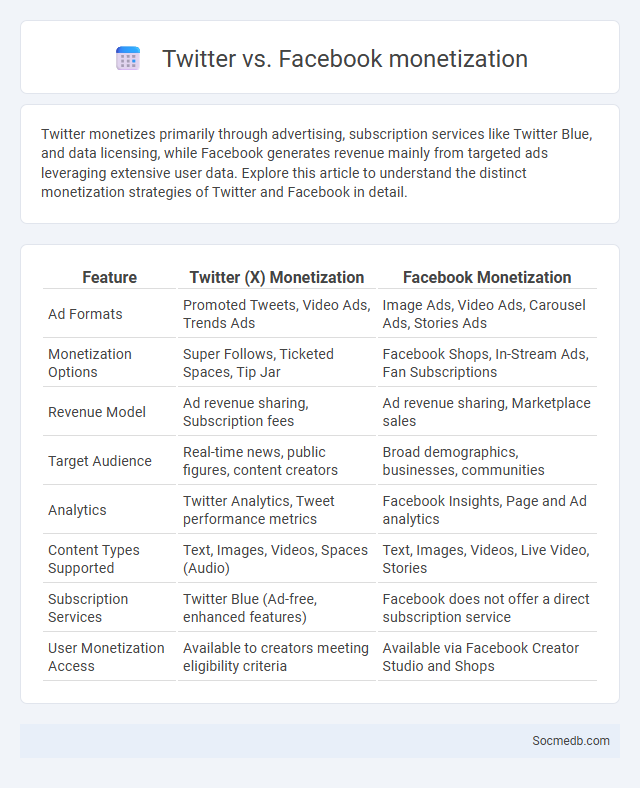
Photo illustration: Twitter vs Facebook monetization
Twitter monetizes primarily through advertising, subscription services like Twitter Blue, and data licensing, while Facebook generates revenue mainly from targeted ads leveraging extensive user data. Explore this article to understand the distinct monetization strategies of Twitter and Facebook in detail.
Table of Comparison
| Feature | Twitter (X) Monetization | Facebook Monetization |
|---|---|---|
| Ad Formats | Promoted Tweets, Video Ads, Trends Ads | Image Ads, Video Ads, Carousel Ads, Stories Ads |
| Monetization Options | Super Follows, Ticketed Spaces, Tip Jar | Facebook Shops, In-Stream Ads, Fan Subscriptions |
| Revenue Model | Ad revenue sharing, Subscription fees | Ad revenue sharing, Marketplace sales |
| Target Audience | Real-time news, public figures, content creators | Broad demographics, businesses, communities |
| Analytics | Twitter Analytics, Tweet performance metrics | Facebook Insights, Page and Ad analytics |
| Content Types Supported | Text, Images, Videos, Spaces (Audio) | Text, Images, Videos, Live Video, Stories |
| Subscription Services | Twitter Blue (Ad-free, enhanced features) | Facebook does not offer a direct subscription service |
| User Monetization Access | Available to creators meeting eligibility criteria | Available via Facebook Creator Studio and Shops |
Introduction: The Monetization Landscape
Social media platforms have transformed into lucrative ecosystems where user engagement directly translates into revenue opportunities. Your content, when strategically crafted and targeted, can unlock various monetization channels such as sponsored posts, affiliate marketing, and ad revenue sharing. Understanding the monetization landscape enables you to optimize your online presence and maximize income potential effectively.
Twitter Monetization: Features and Tools
Twitter monetization offers a variety of features and tools designed to help creators earn revenue directly from their content. Key options include Super Follows, which enable followers to subscribe for exclusive content, and Ticketed Spaces, allowing hosts to charge for access to live audio events. The Tip Jar feature facilitates one-time payments, while Twitter's Amplify program helps content creators monetize videos through pre-roll ads and sponsorships.
Facebook Monetization: Opportunities and Methods
Facebook monetization offers diverse opportunities including ad revenue through Facebook Audience Network, brand collaborations via influencer marketing, and fan subscriptions for exclusive content. Methods such as in-stream ads, branded content partnerships, and Stars enable creators to generate income directly from their audience. Leveraging Facebook's vast user base and targeting capabilities enhances monetization potential for businesses and individual creators alike.
Creator Monetization: Defining the Concept
Creator monetization refers to the process by which individuals generate revenue from content they produce and share on social media platforms. Your ability to leverage various tools such as brand partnerships, subscription models, and platform-specific features like YouTube's Super Chat or Instagram's branded content enables sustainable income streams. Understanding these monetization strategies is crucial for maximizing your earnings and building a long-term digital career.
Revenue Streams: Twitter vs. Facebook for Creators
Twitter's revenue streams for creators primarily include Super Follows, Ticketed Spaces, and Tips, enabling direct fan support and exclusive content monetization. Facebook offers more diverse options like Stars, in-stream ads, fan subscriptions, and branded content tools that help creators maximize earnings through broader audience engagement. Understanding these platforms' monetization features allows you to strategically boost your social media income by aligning your content with the most profitable revenue sources.
Eligibility Requirements: Platform Comparison
Social media platforms each have distinct eligibility requirements based on user age, location, and content guidelines, influencing your ability to create accounts and access features. For instance, Facebook requires users to be at least 13 years old with valid identification in regions with stricter regulations, while LinkedIn targets professionals aged 16 and above. Understanding the specific policies of platforms like Instagram, TikTok, and Twitter ensures compliance and optimizes your social media presence according to their user criteria.
Audience Engagement: Impact on Monetization
High audience engagement on social media platforms significantly boosts monetization opportunities by increasing content visibility and fostering brand loyalty. Metrics such as likes, comments, shares, and watch time directly influence algorithmic promotion, leading to higher ad revenue and sponsorship deals. Brands that cultivate active interactions often experience enhanced customer retention and greater conversion rates, driving sustained financial growth.
Payment Structures and Revenue Share
Social media platforms generate revenue primarily through advertising payments, subscription fees, and in-app purchases, with payment structures tailored to user engagement and content monetization. Revenue share models often allocate a percentage of earnings to creators based on content performance metrics such as views, clicks, or interactions, incentivizing high-quality and frequent content production. Major platforms like YouTube, Instagram, and TikTok typically offer revenue splits ranging from 45% to 70% for creators, balancing platform profits with influencer compensation.
Challenges and Limitations for Creators
Social media platforms present creators with challenges such as algorithmic unpredictability, which can limit content visibility and audience reach. Monetization difficulties arise from platform policies and revenue-sharing models that often disadvantage smaller creators. Content saturation leads to intense competition, making it harder for creators to establish unique brand identities and maintain long-term engagement.
Choosing the Right Platform: Which Monetization Works?
Choosing the right social media platform depends on your target audience, content type, and monetization goals. Platforms like YouTube and TikTok excel in ad revenue and brand partnerships, while Instagram and Pinterest offer strong affiliate marketing and sponsored content opportunities. Understanding how your content aligns with each platform's monetization methods helps maximize your social media income potential.
 socmedb.com
socmedb.com